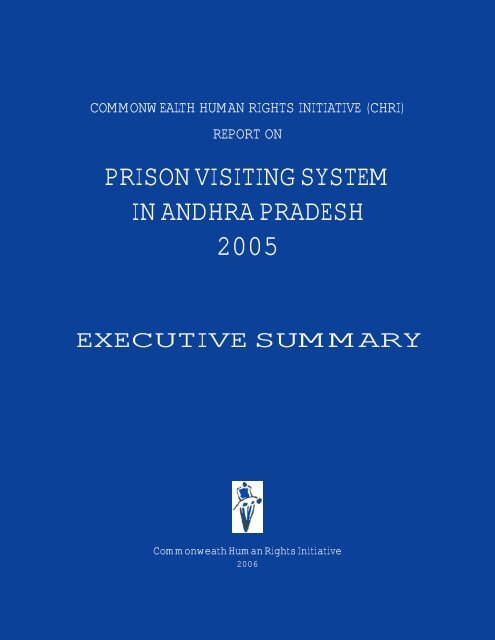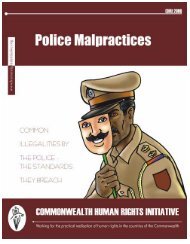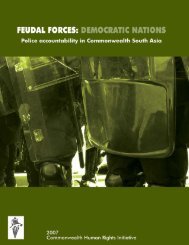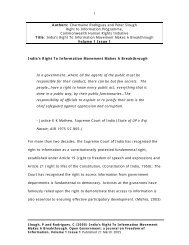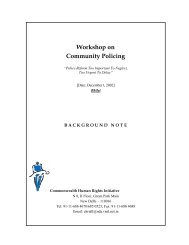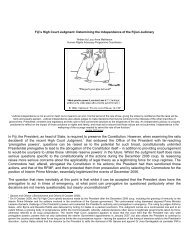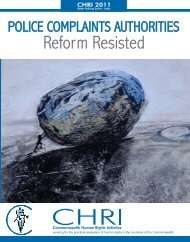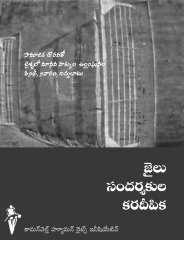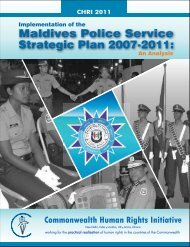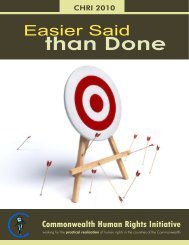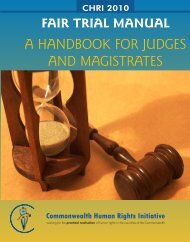Prison Visiting System in Andhra Pradesh - Commonwealth Human ...
Prison Visiting System in Andhra Pradesh - Commonwealth Human ...
Prison Visiting System in Andhra Pradesh - Commonwealth Human ...
You also want an ePaper? Increase the reach of your titles
YUMPU automatically turns print PDFs into web optimized ePapers that Google loves.
COMMONWEALTH HUMAN RIGHTS INITIATIVE (CHRI)<br />
REPORT ON<br />
PRISON VISITING SYSTEM<br />
IN ANDHRA PRADESH<br />
2005<br />
EXECUTIVE SUMMARY<br />
Commonweath <strong>Human</strong> Rights Initiative<br />
2006
<strong>Commonwealth</strong> <strong>Human</strong> Rights Initiative (CHRI), New Delhi<br />
The <strong>Commonwealth</strong> <strong>Human</strong> Rights Initiative (CHRI) is an <strong>in</strong>dependent, non-partisan, <strong>in</strong>ternational non-governmental<br />
organisation, mandated to ensure the practical realisation of human rights <strong>in</strong> the countries of the <strong>Commonwealth</strong>. In 1987,<br />
several <strong>Commonwealth</strong> professional associations founded CHRI. They believed that while the <strong>Commonwealth</strong> provided member<br />
countries a shared set of values and legal pr<strong>in</strong>ciples from which to work and provided a forum with<strong>in</strong> which to promote human<br />
rights, there was little focus on the issues of human rights with<strong>in</strong> the <strong>Commonwealth</strong>.<br />
The objectives of CHRI are to promote awareness of and adherence to the <strong>Commonwealth</strong> Harare Pr<strong>in</strong>ciples, the Universal<br />
Declaration of <strong>Human</strong> Rights and other <strong>in</strong>ternationally recognised human rights <strong>in</strong>struments, as well as domestic <strong>in</strong>struments<br />
support<strong>in</strong>g human rights <strong>in</strong> <strong>Commonwealth</strong> member states.<br />
Through its reports and periodic <strong>in</strong>vestigations, CHRI cont<strong>in</strong>ually draws attention to progress and setbacks to human rights <strong>in</strong><br />
<strong>Commonwealth</strong> countries. In advocat<strong>in</strong>g for approaches and measures to prevent human rights abuses, CHRI addresses the<br />
<strong>Commonwealth</strong> Secretariat, member governments and civil society associations. Through its public education programmes,<br />
policy dialogues, comparative research, advocacy and network<strong>in</strong>g, CHRI’s approach throughout is to act as a catalyst around<br />
its priority issues.<br />
The nature of CHRI’s sponsor<strong>in</strong>g organisations* allows for a national presence and an <strong>in</strong>ternational network. These professionals<br />
can also steer public policy by <strong>in</strong>corporat<strong>in</strong>g human rights norms <strong>in</strong>to their own work and act as a conduit to dissem<strong>in</strong>ate<br />
human rights <strong>in</strong>formation, standards and practices. These groups also br<strong>in</strong>g local knowledge, can access policy makers,<br />
highlight issues, and act <strong>in</strong> concert to promote human rights.<br />
CHRI is based <strong>in</strong> New Delhi, India, and has offices <strong>in</strong> London, UK, and Accra, Ghana.<br />
International Advisory Committee: Sam Okudzeto - Chairperson. Members: Eunice Brookman-Amissah, Murray Burt, Jean Corston,<br />
Maja Daruwala, Alison Duxbury, Nihal Jayawickrama, B.G. Verghese, Zohra Yusuf.<br />
Executive Committee: B.G. Verghese - Chairperson; Maja Daruwala - Director. Members: Anu Aga, B.K. Chandrashekar, Bhagwan<br />
Das, Nit<strong>in</strong> Desai, K.S. Dhillon, Harivansh, Sanjoy Hazarika, Poonam Muttreja, R.V. Pillai, Moolchand Sharma.<br />
Trustee Committee: Nihal Jayawickrama - Chairperson. Members: Meenakshi Dhar, John Hatchard, Derek Ingram, Neville L<strong>in</strong>ton,<br />
Col<strong>in</strong> Nicholls, L<strong>in</strong>dsay Ross, Peter Sl<strong>in</strong>n, Elizabeth Smith.<br />
* <strong>Commonwealth</strong> Journalists Association, <strong>Commonwealth</strong> Lawyers Association, <strong>Commonwealth</strong> Legal Education Association,<br />
<strong>Commonwealth</strong> Parliamentary Association, <strong>Commonwealth</strong> Press Union and <strong>Commonwealth</strong> Broadcast<strong>in</strong>g Association.<br />
Design & Layout : Ranjan Kumar S<strong>in</strong>gh, CHRI<br />
Material from this report may be used, duly acknowledg<strong>in</strong>g the source.<br />
<strong>Commonwealth</strong> <strong>Human</strong> Rights Initiative<br />
CHRI Headquarters CHRI London Office CHRI Africa Office<br />
B-117, First Floor C/o Institute of <strong>Commonwealth</strong> Studies C/o The British Council<br />
Sarvodaya Enclave 28, Russell Square PO Box GP 771<br />
New Delhi - 110017, INDIA London WC1B 5DS, UK Accra, Ghana<br />
Tel: +91-11-2685-0523, 2686-4678 Tel: +44-020-7-862-8857 Tel: +233-21-683068, 683069, 683070<br />
Fax: +91-11-2686-4688 Fax: +44-020-7-862-8820 Fax: +233-21-683062<br />
E-mail: chriall@nda.vsnl.net.<strong>in</strong> E-mail: chri@sas.ac.uk E-mail: CHRI@gh.britishcouncil.org<br />
Website: www.humanrights<strong>in</strong>itiative.org
COMMONWEALTH HUMAN RIGHTS INITIATIVE (CHRI)<br />
REPORT ON<br />
PRISON VISITING SYSTEM<br />
IN ANDHRA PRADESH<br />
2005<br />
EXECUTIVE SUMMARY<br />
Researched and Written<br />
By<br />
Dr. Murali Karnam<br />
Consultant, CHRI<br />
Edit<strong>in</strong>g & Foreword<br />
By<br />
Maja Daruwala<br />
Director, CHRI<br />
Commonweath <strong>Human</strong> Rights Initiative<br />
2006
Contents<br />
Acknowledgements ......................................................................................................................... 1<br />
Foreword: Introduction, Objectives, Methodology .......................................................................2<br />
Major F<strong>in</strong>d<strong>in</strong>gs<br />
1. Official Visitors to <strong>Prison</strong>s<br />
1.1 District Collectors .............................................................................................................5<br />
1.2 District Judges and Magistrates ........................................................................................5<br />
1.3 Director of Medical and Health Services ............................................................................6<br />
1.4 District Educational Officers .............................................................................................6<br />
1.5 Other Ex-officio Visitors ....................................................................................................6<br />
2. Non-Official Visitors (NOVs) to <strong>Prison</strong>s<br />
2.1 Selection criteria followed <strong>in</strong> the appo<strong>in</strong>tment of NOVs.......................................................7<br />
2.2 Number of NOVs appo<strong>in</strong>ted .............................................................................................7<br />
2.3 Procedure followed <strong>in</strong> the appo<strong>in</strong>tment of NOVs ................................................................8<br />
2.4 Communication of appo<strong>in</strong>tment orders .............................................................................8<br />
2.5 Roster for prison visit<strong>in</strong>g ....................................................................................................8<br />
2.6 Supply of rules and guidel<strong>in</strong>es for NOVs ............................................................................9<br />
2.7 Display of names of prison visitors .....................................................................................9<br />
2.8 Periodicity of visits .............................................................................................................9<br />
2.9 <strong>Prison</strong> visitors’ notes ...................................................................................................... 10<br />
2.10 Function<strong>in</strong>g of board of visitors (BOV) to prisons ............................................................. 11<br />
Major Recommendations<br />
1. Official Visitors to <strong>Prison</strong>s<br />
1.1 Function<strong>in</strong>g of official visitors ......................................................................................... 12<br />
2. Non-Official Visitors (NOVs) to <strong>Prison</strong>s<br />
2.1 Selection criteria ............................................................................................................ 12<br />
2.2 Number of NOVs .......................................................................................................... 13<br />
2.3 Procedure of appo<strong>in</strong>tment of NOVs ............................................................................... 13<br />
2.4 Responsibility of communication of appo<strong>in</strong>tment of NOVs ............................................... 13<br />
2.5 Roster for prison visit<strong>in</strong>g by NOVs .................................................................................. 13<br />
2.6 Supply of guidel<strong>in</strong>es to NOVs ......................................................................................... 14<br />
2.7 Display of names and addresses of visitors and roster ..................................................... 14<br />
2.8 Frequency of visits ......................................................................................................... 14<br />
2.9 <strong>Prison</strong> visitors’ notes ...................................................................................................... 15<br />
2.10 Board of visitors (BOV) .................................................................................................. 15<br />
2.11 General work<strong>in</strong>g conditions ........................................................................................... 16<br />
2.12 <strong>Prison</strong> rules ................................................................................................................... 16<br />
Annexure:<br />
Draft of proposed amendments <strong>in</strong> rules framed under<br />
sections 59 (25) of the <strong>Prison</strong>s Act 1894<br />
(Chapter IV of AP <strong>Prison</strong> Rules 1979.............................................................................. 17
Acknowledgements<br />
We would like to thank everyone who contributed to the study and express our appreciation to all the prison<br />
officials, district sub-jail officers, prison doctors, district collectors, district judges, retired prison officers and the<br />
non-official visitors who took time out of their busy schedules to meet and talk with us <strong>in</strong> the course of this study.<br />
To Rakesh Srivastav and Reshma Radhakrishnan, a special thanks for their help dur<strong>in</strong>g field visits.<br />
We are grateful to the National <strong>Human</strong> Rights Commission for recommend<strong>in</strong>g CHRI to the government of<br />
<strong>Andhra</strong> <strong>Pradesh</strong> to undertake this study and to the government of <strong>Andhra</strong> <strong>Pradesh</strong>, particularly Shri M.A. Basith,<br />
IPS, the Director General and Inspector General of <strong>Prison</strong>s and Correctional Services, AP, for access to data and<br />
19 major prisons and prison headquarters. We would also like to thank Mr R.K. Saxena, Coord<strong>in</strong>ator of CHRI’s<br />
prisons programme, for provid<strong>in</strong>g overall guidance and shar<strong>in</strong>g with us his expertise <strong>in</strong> prison reforms throughout<br />
the study and draft<strong>in</strong>g process of the report. Last but not least we would like to thank the many prison<br />
<strong>in</strong>mates who shared their experiences with candor and hope for a better tomorrow.<br />
<strong>Commonwealth</strong> <strong>Human</strong> Rights Initiative<br />
April 2006<br />
1
Foreword<br />
Introduction<br />
It is not for noth<strong>in</strong>g that <strong>in</strong> less enlightened times prisons were sometimes known as oubliettes or places of the<br />
forgotten. In modern times the world and the Indian crim<strong>in</strong>al justice system has moved away from the <strong>in</strong>herently<br />
cruel and medieval ‘lock-em-up and throw away the key’ approach towards crime and punishment and espoused<br />
- <strong>in</strong> theory at least - a rehabilitative approach. <strong>Prison</strong>s are now known nearly everywhere as ‘correctional<br />
facilities’ <strong>in</strong>dicat<strong>in</strong>g their purpose as places that, while necessarily designed to hold people <strong>in</strong>, do so with the<br />
ultimate aim of rehabilitat<strong>in</strong>g offenders and releas<strong>in</strong>g them back <strong>in</strong>to society as productive members able to<br />
contribute positively to their environments. The new philosophy sees <strong>in</strong>carceration as a temporary phase along<br />
the path to rehabilitation: necessary <strong>in</strong> some circumstances either to punish or to isolate but not compulsory or<br />
endless.<br />
Nevertheless, across the world prisons are a low-priority concern. Governments, especially those strapped for<br />
cash, provide the least they can and neglect the prisons department, its staff, <strong>in</strong>frastructure and build<strong>in</strong>gs, as<br />
well as pay scant attention to the rights and conditions of the prisoners. Equally, society grudges expenditure or<br />
attention given to people perceived as undeserv<strong>in</strong>g wrongdoers, especially <strong>in</strong> a country where millions of poor<br />
barely subsist.<br />
This neglect has its costs and society has a stake <strong>in</strong> ensur<strong>in</strong>g prisons are run well. Staff - themselves often liv<strong>in</strong>g<br />
locked <strong>in</strong> lifelong environments ak<strong>in</strong> to the convicted - are demoralised and de-motivated. They perform poorly<br />
and prisons become places of risk, danger and rights violation that negatively impact the world outside their iron<br />
gates.<br />
Unreformed and unsupervised prisons, locked away from societal <strong>in</strong>tervention, become schools for crim<strong>in</strong>ality<br />
and now hothouses for quick spread<strong>in</strong>g diseases like tuberculosis, sexually transmitted diseases and the terrible<br />
HIV/AIDS, that are easily communicable <strong>in</strong>to crowded societies.<br />
Beyond concern for physical well-be<strong>in</strong>g, society has a stake <strong>in</strong> ensur<strong>in</strong>g that prisoners’ rights are well protected.<br />
Our constitutional form of government clothes each citizen with fundamental rights that must be protected <strong>in</strong> all<br />
circumstances – prison is no exception. A citizen <strong>in</strong> custody suffers no reduction of rights beyond that which is<br />
absolutely unavoidable by virtue of be<strong>in</strong>g deprived of freedom. In fact, <strong>in</strong> prison, because it has sole and complete<br />
control over the citizen, the State has a special duty of care to ensure that the citizen <strong>in</strong> custody is not<br />
exposed to any additional danger nor put at any greater risk while <strong>in</strong> custody of the State than when free. The<br />
habitual violation of prisoners’ rights - that range from not ensur<strong>in</strong>g safety and security, to not ensur<strong>in</strong>g easy<br />
access to effective legal aid nor produc<strong>in</strong>g remand prisoners <strong>in</strong> court on hear<strong>in</strong>g dates because no transportation<br />
has been arranged - affects each of us because we are subject to the same justice system that habitually<br />
demonstrates it cannot ensure the m<strong>in</strong>imum guarantees of access to justice are properly met.<br />
This duty to be concerned with the conditions of <strong>in</strong>carceration and the rights of persons <strong>in</strong> custody is underl<strong>in</strong>ed<br />
by the reality that the majority of persons go<strong>in</strong>g through the prison system are not crim<strong>in</strong>als but simply people<br />
wait<strong>in</strong>g out their time through the lengthy court process. Under-trial prisoners are almost <strong>in</strong>evitably poor people<br />
<strong>in</strong> for petty crimes. Much of their crime is driven by desperation, ignorance and poverty. Nevertheless, the<br />
creak<strong>in</strong>g crim<strong>in</strong>al justice system bears down much more heavily and much more unfairly on the poor. Often<br />
unable to f<strong>in</strong>d effective legal representation or the means to bail themselves out, they spend unacceptably long<br />
periods – sometimes more than the maximum penalty - deprived of freedom while their guilt or <strong>in</strong>nocence<br />
2
ema<strong>in</strong>s to be decided <strong>in</strong> a system hallmarked by delays. In <strong>Andhra</strong> <strong>Pradesh</strong>, prisoners await<strong>in</strong>g trial account for<br />
an average of 65% of the total prison population.<br />
Simply said, <strong>in</strong> prisons of <strong>Andhra</strong> <strong>Pradesh</strong> there are just too many people who should not be there. The remedies<br />
for stopp<strong>in</strong>g this <strong>in</strong>justice and for reduc<strong>in</strong>g the chronic overcrowd<strong>in</strong>g that overburdens the jail adm<strong>in</strong>istration,<br />
are all <strong>in</strong> place <strong>in</strong> law - bail rather than jail; effective legal defence; periodic jail house hear<strong>in</strong>gs by judges aimed<br />
at deliver<strong>in</strong>g quick decisions; lok adalats; parole for well-behaved and long-term prisoners; probation. But <strong>in</strong> the<br />
absence of anyone look<strong>in</strong>g over the walls of the shuttered prison system, the remedies rema<strong>in</strong> under-utilised and<br />
the jails cont<strong>in</strong>ue to fill and fester creat<strong>in</strong>g embittered alienated people who have little support or ability to<br />
<strong>in</strong>tegrate <strong>in</strong>to society.<br />
The prison visit<strong>in</strong>g system is one more statutory but under-utilised means of mend<strong>in</strong>g the chronically ail<strong>in</strong>g prison<br />
system. The prison visit<strong>in</strong>g system is legally mandated. It allows regulated social <strong>in</strong>terventions <strong>in</strong>to penal <strong>in</strong>stitutions.<br />
Laypersons, or non-official visitors, along with ex officio members, are appo<strong>in</strong>ted by government to sit on<br />
a board of visitors (BOV). Its function is to visit prisons, monitor conditions and support and supplement the<br />
adm<strong>in</strong>istration with resources mobilised from society. The aim is to make sure that the prison is runn<strong>in</strong>g well and<br />
<strong>in</strong> accordance with regulation, reduce its isolation, br<strong>in</strong>g comfort and assistance to <strong>in</strong>mates, help <strong>in</strong> their rehabilitation<br />
and <strong>in</strong>tegration <strong>in</strong>to society, and support the prison adm<strong>in</strong>istration <strong>in</strong> ramp<strong>in</strong>g up reformative activities.<br />
This approach of <strong>in</strong>volv<strong>in</strong>g communities <strong>in</strong> prison activities is emphatically advocated the world over and endorsed<br />
by the United Nation and other <strong>in</strong>ternational bodies. In India, the Supreme Court has several times<br />
reaffirmed the importance of prison visits by official and non-official visitors <strong>in</strong> the conservation of the human<br />
rights of prisoners. In <strong>Andhra</strong> <strong>Pradesh</strong>, after a bit of nudg<strong>in</strong>g by the High Court, the government has been<br />
appo<strong>in</strong>t<strong>in</strong>g non-official visitors to various prisons s<strong>in</strong>ce 1997.<br />
Nevertheless the prison visit<strong>in</strong>g system works far from well. It is little known and under-resourced. BOVs, if they<br />
are constituted at all, rarely meet; visitors are appo<strong>in</strong>ted late or not at all; loose criteria for appo<strong>in</strong>tment do not<br />
draw <strong>in</strong> the most suitable candidates; diversity of class, gender, and professional experience is poor; all prisons<br />
are not equally well covered; for the most part visitors do not know their role and function; visits are irregular,<br />
<strong>in</strong>frequent or do not happen at all; poor quality and <strong>in</strong>complete visit<strong>in</strong>g notes are of little assistance to the<br />
adm<strong>in</strong>istration and cannot ground improvements; and, most importantly, no one is held to account for not<br />
fulfill<strong>in</strong>g their duties under the system.<br />
Nevertheless, the prison visit<strong>in</strong>g system has great potential for creat<strong>in</strong>g change <strong>in</strong> a system that is <strong>in</strong>creas<strong>in</strong>gly<br />
ga<strong>in</strong><strong>in</strong>g <strong>in</strong>ternational notoriety, but at present it is <strong>in</strong> bad need of attention and improvement.<br />
This is the primary assumption of the present study as CHRI believes that if properly chosen, sensitised and<br />
tra<strong>in</strong>ed about their obligations and responsibilities as per the prison manual, non-official and official visitors can<br />
together ensure a well-function<strong>in</strong>g prison visit<strong>in</strong>g system that will act as a catalyst for br<strong>in</strong>g<strong>in</strong>g about positive<br />
changes all along the connected cha<strong>in</strong> of the crim<strong>in</strong>al justice system, prodd<strong>in</strong>g each of its l<strong>in</strong>ks to perform better<br />
and so improve the whole.<br />
To create a well-function<strong>in</strong>g prison visit<strong>in</strong>g system does not need more f<strong>in</strong>ances or manpower from the State.<br />
Nor does it call for any difficult re-organisation of the present system. It merely needs the State to act <strong>in</strong> obedience<br />
of the exist<strong>in</strong>g laws, rules and regulations and, for those mandated to make the system work, to carry out<br />
their duties with due diligence. It is not too much to ask.<br />
3
Objectives<br />
The objective of the study was to exam<strong>in</strong>e the present state of the statutorily mandated prison visit<strong>in</strong>g system <strong>in</strong><br />
<strong>Andhra</strong> <strong>Pradesh</strong> and to make practical recommendations for its improvement. In particular, CHRI studied how<br />
prison visitors are selected; what criteria is used to identify and f<strong>in</strong>alise nom<strong>in</strong>ations; what understand<strong>in</strong>g NOVs<br />
have of their roles, responsibilities, rules and laws that govern the prison; whether visitors fulfill duties and<br />
functions accord<strong>in</strong>g to the statutory guidel<strong>in</strong>es <strong>in</strong> the prison manual and court judgments that form part of the<br />
law; what is outl<strong>in</strong>ed <strong>in</strong> the constitution of visit<strong>in</strong>g boards <strong>in</strong> terms of the periodicity of visits, the process<strong>in</strong>g of<br />
visit<strong>in</strong>g notes and of action taken on the observations made by visitors; and the mutual perceptions and the<br />
relationships between the NOVs and prison staff.<br />
Methodology<br />
The report and its observations are based on visits to 20 prisons between January 2005 and July 2005 by a<br />
study team that <strong>in</strong>terviewed 66 prisoners, 53 NOVs, 17 prison doctors, 11 judicial and legal aid officers, retired<br />
prison officers, social workers <strong>in</strong> the prisons and 7 district magistrates. The secondary data for the study was<br />
collected from prison headquarters. In order to ensure a sound empirical basis for recommendations we<br />
reviewed data, adm<strong>in</strong>istered questionnaires to all the officials and non-officials concerned with the prison visit<strong>in</strong>g<br />
system, and supplemented these with personal <strong>in</strong>terviews with prisoners, prison staff, district magistrates,<br />
retired prison officers and NOVs.<br />
Maja Daruwala<br />
Director<br />
<strong>Commonwealth</strong> <strong>Human</strong> Rights Initiative<br />
New Delhi<br />
May 2006<br />
4
MAJOR FINDINGS
1. Official Visitors to <strong>Prison</strong>s<br />
1.1 District Collectors<br />
MAJOR FINDINGS<br />
Standard<br />
Accord<strong>in</strong>g to <strong>Andhra</strong> <strong>Pradesh</strong> <strong>Prison</strong> Rules 1979 all official visitors are required to meet and<br />
<strong>in</strong>spect prisons once <strong>in</strong> a quarter. They must talk to prisoners, hear any compla<strong>in</strong>ts and satisfy<br />
themselves that liv<strong>in</strong>g conditions are satisfactory. The district collector as the chair of the board<br />
of visitors (BOV) is required to call for a board meet<strong>in</strong>g once <strong>in</strong> every quarter and arrange a<br />
roster for visits and send notices to official and non-official visitors to avail their turn.<br />
Reality<br />
1. Almost all the district collectors are unaware that accord<strong>in</strong>g to the prison manual they are<br />
ex-officio chairpersons for the BOVs.<br />
2. Some of them are not aware that they are responsible for constitut<strong>in</strong>g BOVs to prisons.<br />
3. Even where visits are made, they rarely record their suggestions to improve prison conditions<br />
<strong>in</strong> the <strong>Prison</strong> Visitors’ Book.<br />
1.2 District Judges and Magistrates<br />
Standard<br />
All magistrates and judges are required to visit the prisons as frequently as possible to oversee<br />
the liv<strong>in</strong>g conditions of prisoners and address the problems of under-trial prisoners.<br />
Reality<br />
1. Though judicial officers visit prisons more frequently than any other category of visitor, they<br />
limit their <strong>in</strong>terventions to issues relat<strong>in</strong>g to judicial proceed<strong>in</strong>gs of cases of under-trial prisoners<br />
rather than prison conditions as such.<br />
2. Despite these visits, there are no mandatory prisoners’ grievance deposit boxes <strong>in</strong>stalled <strong>in</strong> any of<br />
the prisons that would allow prisoners to communicate directly with judicial officers about legal<br />
aid, liv<strong>in</strong>g conditions and health care <strong>in</strong> the prisons. 1 Nor is attention paid to other legal safeguards<br />
or comments recorded <strong>in</strong> terms of compliance with human rights commissions’ guidel<strong>in</strong>es<br />
from time to time by the Supreme Court or human rights commissions.<br />
3. Almost all district magistrates confessed that they are not aware of the concept of BOVs <strong>in</strong><br />
prisons and its functions. Nor were they aware of the provisions <strong>in</strong> the <strong>Prison</strong> Manual.<br />
4. Nevertheless, most district magistrates accepted that <strong>in</strong> order to improve the function<strong>in</strong>g of<br />
prisons and prisoners liv<strong>in</strong>g conditions, there was a need to hold regular BOV meet<strong>in</strong>gs.<br />
5. District magistrates expect prison super<strong>in</strong>tendents to take the <strong>in</strong>itiative to hold regular meet<strong>in</strong>gs<br />
of BOVs.<br />
1<br />
Sunil Batra II v/s Delhi Adm<strong>in</strong>istration, 1980 (3) Supreme Court Cases, page 488.<br />
5
1.3 Director of Medical and Health Services<br />
Standard<br />
The director of medical and health services is a member of the BOV of all the prisons. As the<br />
head of the public health system, he is expected to contribute to design an effective prison<br />
medical service and address the problems of access<strong>in</strong>g better health services by the prisoners<br />
and prison staff.<br />
Reality<br />
1. Between 2003-2004, the Director of Medical and Health Services did not visit a s<strong>in</strong>gle<br />
prison <strong>in</strong> the state. In fact there is no such tradition <strong>in</strong> practice.<br />
2. In the same period, the district medical officers made 11 visits to 6 prisons but 11 others<br />
were not visited even once.<br />
3. They rarely put down their suggestions to the prison officials <strong>in</strong> black and white.<br />
1.4 District Educational Officers<br />
Standard<br />
District education officers are part of the ex-officio membership of the BOV. They are <strong>in</strong>cluded <strong>in</strong><br />
order to use their particular position to advantage prisoners. Their presence is <strong>in</strong>tended to ensure<br />
some degree of exposure to education and improvement <strong>in</strong> prisoner literacy and vocational<br />
abilities so that there is a real chance of their be<strong>in</strong>g able to earn a liv<strong>in</strong>g outside prison. District<br />
educational officers’ duties <strong>in</strong>clude visit<strong>in</strong>g prisons accord<strong>in</strong>g to the roster and <strong>in</strong> particular,<br />
see<strong>in</strong>g to the improvement of access to learn<strong>in</strong>g opportunities and vocational tra<strong>in</strong><strong>in</strong>gs.<br />
Reality<br />
1. Between January 2003 and December 2004 only three District Educational Officers had<br />
visited their respective prisons; the rest had not.<br />
2. Even where they had visited, educational officers had made no comments that covered their<br />
areas of responsibility or about general conditions. There was no evidence to suggest that<br />
they had paid particular attention to the development of libraries or the appo<strong>in</strong>tment of<br />
regular teach<strong>in</strong>g staff.<br />
1.5 Other Ex-officio Visitors<br />
Standard<br />
Representatives of <strong>in</strong>dustries, fire services, factory <strong>in</strong>spectorate, members of the legislative assembly<br />
are also <strong>in</strong>cluded <strong>in</strong> order to broad base the BOV and ensure that the jail adm<strong>in</strong>istration<br />
has assistance and oversight <strong>in</strong> ensur<strong>in</strong>g adequate work, wages and safe work<strong>in</strong>g conditions.<br />
Reality<br />
1. Between January 2003 and December 2004, the Director of Industries had visited just two<br />
of the 20 prisons.<br />
2. The Chief Inspector of Factories and senior fire officers of the locality had visited only the<br />
central prison at Warangal dur<strong>in</strong>g the period. None of the other 19 prisons had been visited<br />
even once.<br />
3. Members of Legislative Assembly, who are ex-officio NOVs to the prisons located <strong>in</strong> their<br />
constituency, had made 11 visits dur<strong>in</strong>g the period and no people’s representative ever<br />
visited 6 of the 20 prisons we exam<strong>in</strong>ed.<br />
6
2. Non-Official Visitors (NOVs) to <strong>Prison</strong>s<br />
2.1 Selection criteria followed <strong>in</strong> the appo<strong>in</strong>tment of NOVs<br />
Standard<br />
The prison manual does not provide any explicit criteria for the selection of the non-official<br />
visitors. Neither has the government formulated criteria aga<strong>in</strong>st which to make selections. This is<br />
the fundamental and serious flaw <strong>in</strong> the system.<br />
Reality<br />
1. Lack of criteria, most of the time, leads to <strong>in</strong>clusion of persons as prison visitors for reasons<br />
that have little to do with their abilities, the needs of prisoners, or relevance to specific prisons<br />
and leads to the identification and appo<strong>in</strong>tment of candidates with little discernable<br />
<strong>in</strong>terest <strong>in</strong> prison improvement and oversight.<br />
2. Often, NOVs are drawn from amongst already busy local professionals from medic<strong>in</strong>e, law,<br />
bus<strong>in</strong>ess and academics. They have little specific knowledge of prisons and little time to<br />
spare to visit prisons regularly and do so only to mark attendance on ceremonial public<br />
occasions where there is no possibility of serious <strong>in</strong>teraction with prisoners or observation of<br />
conditions.<br />
3. A number of chronically sick or aged NOVs have been appo<strong>in</strong>ted who (most of them are<br />
retired bureaucrats) never visited prisons but were reappo<strong>in</strong>ted aga<strong>in</strong> and aga<strong>in</strong>. All prisons<br />
have at least one or two NOVs of this sort.<br />
4. NOVs with faith based backgrounds, social work and teach<strong>in</strong>g are the most active and<br />
functional NOVs.<br />
5. Some of the NOVs are housewives of ward counselors who are unfamiliar with public life.<br />
2.2 Number of NOVs appo<strong>in</strong>ted<br />
Standard<br />
NOVs are required to be appo<strong>in</strong>ted to all the prisons <strong>in</strong> the state. Six NOVs, <strong>in</strong>clud<strong>in</strong>g 2 female<br />
members, are required to be appo<strong>in</strong>ted to central prisons and 4 NOVs, <strong>in</strong>clud<strong>in</strong>g 1 female<br />
member, are required to be appo<strong>in</strong>ted to district prisons.<br />
Reality<br />
1. Appo<strong>in</strong>tment of NOVs to sub-jails has never been made although they fall under the category<br />
of ‘prisons’.<br />
2. Appo<strong>in</strong>tment of full complement of prison visitors is not always followed.<br />
3. There is no uniformity <strong>in</strong> the numbers appo<strong>in</strong>ted to the same category of prisons:<br />
• Between 2 and 6 members, <strong>in</strong>clud<strong>in</strong>g women members, are appo<strong>in</strong>ted to central prisons<br />
while between 3 and 4 are appo<strong>in</strong>ted to district jails.<br />
• In district jails where women prisoners are also accommodated, female NOVs had not<br />
been appo<strong>in</strong>ted.<br />
• In some cases, the same NOV was appo<strong>in</strong>ted to two prisons, but had not visited either.<br />
7
2.3 Procedure followed <strong>in</strong> the appo<strong>in</strong>tment of NOVs<br />
Standard<br />
<strong>Prison</strong> regulations require that NOVs be appo<strong>in</strong>ted by the government once <strong>in</strong> two years on the<br />
recommendation of the Inspector General of <strong>Prison</strong>s, who should propose the names <strong>in</strong> consultation<br />
with collectors of the concerned districts.<br />
Reality<br />
1. The procedure followed <strong>in</strong> the appo<strong>in</strong>tment is cumbersome and lengthy. From the stage<br />
propos<strong>in</strong>g names to the publication of appo<strong>in</strong>tments <strong>in</strong> the official gazette, there are 7<br />
stages through which names are processed.<br />
2. On average, it took the government two years and four months to appo<strong>in</strong>t NOVs to each<br />
prison between September 1997 and July 2005.<br />
3. Unlike the system followed <strong>in</strong> other states where appo<strong>in</strong>tments of NOVs to all the prisons are<br />
made at the same time <strong>in</strong> a s<strong>in</strong>gle process, appo<strong>in</strong>tments <strong>in</strong> <strong>Andhra</strong> <strong>Pradesh</strong> are made<br />
separately for each prison.<br />
4. District collectors depend mostly on lower level revenue officials and prison officials for nom<strong>in</strong>ations.<br />
2.4 Communication of appo<strong>in</strong>tment orders<br />
Standard<br />
Once the appo<strong>in</strong>tment is published <strong>in</strong> the government gazette, the district collectors are required<br />
to call for an early meet<strong>in</strong>g of all the appo<strong>in</strong>tees and communicate the same to them.<br />
Reality<br />
1. Appo<strong>in</strong>tments do not get communicated to the newly appo<strong>in</strong>ted NOVs for months and<br />
sometimes not at all.<br />
2. After appo<strong>in</strong>tment and publication of orders <strong>in</strong> the government gazette, the Home and <strong>Prison</strong><br />
Departments do not ma<strong>in</strong>ta<strong>in</strong> any record on the communication of appo<strong>in</strong>tment letters or<br />
other communications with NOVs.<br />
3. Despite be<strong>in</strong>g appo<strong>in</strong>ted, NOVs frequently do not receive their appo<strong>in</strong>tment orders and so<br />
do not know they are <strong>in</strong> fact visitors to the prisons. Many hear about their appo<strong>in</strong>tments only<br />
orally. A number of them had not been <strong>in</strong>formed of their appo<strong>in</strong>tments for a year and a half<br />
while others had not received their appo<strong>in</strong>tment orders at any time throughout the entire<br />
two years of their tenure.<br />
4. Where prison officials are <strong>in</strong>volved <strong>in</strong> the identification of NOVs, they take some responsibility<br />
to communicate the appo<strong>in</strong>tment orders.<br />
2.5 Roster for prison visit<strong>in</strong>g<br />
Standard<br />
The district magistrate is required to prepare a roster for prison visits once every two years. It is<br />
required to fix a schedule of visits to be made by <strong>in</strong>dividual visitors both official and non-official.<br />
If the roster is adhered to, jails would be visited on m<strong>in</strong>imum 52 times <strong>in</strong> a year without count<strong>in</strong>g<br />
unscheduled and surprise visits, which are also permitted.<br />
8
Reality<br />
1. In the absence of meet<strong>in</strong>gs of the BOV, most of the NOVs, prison officers and district collectors<br />
are not aware of the roster system for prison visits, except <strong>in</strong> the districts of Kadapa and<br />
East Godavari.<br />
2. In the entire state, the responsibility of official visitors was never fixed through a roster.<br />
3. <strong>Prison</strong> officers were not keen to have rosters prepared for prison visits.<br />
2.6 Supply of rules and guidel<strong>in</strong>es for NOVs<br />
Standard<br />
There is no regulation that requires that rules and guidel<strong>in</strong>es of their role and duties be provided<br />
to appo<strong>in</strong>ted visitors. However, the government did supply this <strong>in</strong>formation to visitors of two<br />
prisons <strong>in</strong> the state.<br />
Reality<br />
1. 95% of NOVs are not aware of guidel<strong>in</strong>es for prison visits, nor are they aware of their<br />
duties and responsibilities.<br />
2. The rules and guidel<strong>in</strong>es for prison visit<strong>in</strong>g were supplied only to those NOVs who were<br />
appo<strong>in</strong>ted dur<strong>in</strong>g the years 1997-99.<br />
3. After 1999, no other NOV was supplied with prison visit<strong>in</strong>g guidel<strong>in</strong>es or po<strong>in</strong>ts to be noted<br />
dur<strong>in</strong>g their visits, either by the prisons department or by district collectors. No district<br />
collector claimed to have copies of prison manuals.<br />
4. Only the district collector of Kadapa supplied a few guidel<strong>in</strong>es as part of roster to all the<br />
NOVs of Kadapa Central <strong>Prison</strong> dur<strong>in</strong>g 2002-2004. As a result, visitors made more visits<br />
to this prison.<br />
2.7 Display of names of prison visitors<br />
Standard<br />
The regulations require that the rosters of visits by official and non-official visits are to be displayed<br />
at the entrance of prison ma<strong>in</strong> gate. This is reconfirmed by the judgment <strong>in</strong> Sunil Batra (II)<br />
case. The need to make norms of function<strong>in</strong>g public is aga<strong>in</strong> re<strong>in</strong>forced by Section 4 of the Right<br />
to Information Act 2005, which also lays down penalties for non-disclosure.<br />
Reality<br />
1. <strong>Prison</strong>s <strong>in</strong> AP do not have a tradition of display<strong>in</strong>g the names of non-official and official<br />
visitors as mandated by the prison manual. This requirement is now re<strong>in</strong>forced by the new<br />
2005 right to <strong>in</strong>formation law.<br />
2. No prison officer claimed to display the names of NOVs even <strong>in</strong> the past.<br />
2.8 Periodicity of visits<br />
Standard<br />
Every NOV is supposed to make at least 10 visits to prisons <strong>in</strong> a year, if weekly rosters are<br />
prepared by the district collectors.<br />
9
Reality<br />
1. 26 % of NOVs never visited the prisons dur<strong>in</strong>g their entire two-year term.<br />
2. Some of the NOVs who never visited were reappo<strong>in</strong>ted for a second term.<br />
3. Only 7 out of 53 NOVs (13%) made the required number of prison visits (20 and above)<br />
dur<strong>in</strong>g their two-year term.<br />
4. More than 50% of visitors only made visits to prisons on three important occasions every<br />
year: 2 October, 15 August and 26 January. These occasions are ceremonial and as such<br />
do not provide occasions for <strong>in</strong>dividual <strong>in</strong>teraction with prison <strong>in</strong>mates.<br />
5. Collective visits by the NOVs are very rare, except dur<strong>in</strong>g celebratory occasions.<br />
6. NOVs’ visits <strong>in</strong> association with Official Visitors are even more rare.<br />
7. NOVs appo<strong>in</strong>ted to Visaka Central <strong>Prison</strong> and district jails of Anantapur and Mahaboobnagar<br />
<strong>in</strong> the last term have not visited them even once dur<strong>in</strong>g their two-year term.<br />
8. Only <strong>in</strong> the Central <strong>Prison</strong> of Kadapa do all the six NOVs regularly visit the prison as per the<br />
roster arranged by the District Collector.<br />
9. In other prisons such as State Jail for Women <strong>in</strong> Hyderabad, District Jail of Nalgonda,<br />
Central <strong>Prison</strong>s of Warangal and Rajahmundry only one or two of the total NOVs appo<strong>in</strong>ted<br />
make regular, if not frequent, visits and rest of them never visit.<br />
10.Only one NOV 1 of the 53 <strong>in</strong>terviewed could provide all the dates of his visits.<br />
11.NOVs with faith based and social work backgrounds visited prisons more frequently than<br />
others.<br />
2.9 <strong>Prison</strong> visitors’ notes<br />
Standard<br />
<strong>Prison</strong> regulations require that visitors write up notes each time they visit on 25 po<strong>in</strong>ts, which<br />
<strong>in</strong>clude check<strong>in</strong>g the quality of food and proper payment of wages etc. Their observations and<br />
suggestions are expected to be acted upon by jail authorities. There is a system by which their<br />
notes reach the BOVs, as well as jail officials and senior m<strong>in</strong>istry officials, and a system by which<br />
observations can be reviewed and kept under scrut<strong>in</strong>y that will ensure adherence to prison rules<br />
and regulations and lead to steady improvements.<br />
Reality<br />
1. Very few visitors, official or non-official, write detailed notes on the conditions of prisons <strong>in</strong><br />
the <strong>Prison</strong> Visitors Book.<br />
2. Most write very sketchy undifferentiated comments that do not <strong>in</strong>dicate what action needs to<br />
be taken by authorities to right bad practice or make improvements.<br />
3. Almost all the notes written by NOVs and official visitors are sent to prison headquarters but<br />
get no response. No suggestion or recommendation made by visitors was ever responded to<br />
by prison officials or prison headquarters <strong>in</strong> the form of action taken reports as required by<br />
the prison rules.<br />
4. We observed that without an early follow-up action, some detailed notes and recommendations<br />
of <strong>in</strong>terested NOVs deteriorated over time and there was decl<strong>in</strong><strong>in</strong>g <strong>in</strong>terest for record<strong>in</strong>g<br />
much of anyth<strong>in</strong>g follow<strong>in</strong>g their visits.<br />
5. Contrary to the rules, sometimes officials do not make visitors’ books available to the visitors.<br />
6. Frequently prison officials discourage NOVs from record<strong>in</strong>g their comments and suggestions<br />
<strong>in</strong> the Visitors’ Book.<br />
2<br />
GV Kondappa, a retired prison official of Kadapa Central <strong>Prison</strong><br />
10
2.10 Function<strong>in</strong>g of board of visitors (BOVs) to prisons<br />
Standard<br />
The executive magistrate or district collector who heads up the district adm<strong>in</strong>istration is bound to<br />
constitute and convene regular meet<strong>in</strong>gs of a BOV. The board is made up of several persons<br />
who are there as officials of the local adm<strong>in</strong>istration and the appo<strong>in</strong>ted NOVs of the jail/district.<br />
The board is required to meet once <strong>in</strong> a quarter, make at least 4 visits a year, create a roster for<br />
<strong>in</strong>dividual visits, make surprise visits, and review whether action has been taken on their suggestions<br />
and send a report to the government.<br />
Reality<br />
1. In the past one decade, no district magistrate has ever called for a BOV meet<strong>in</strong>g at any<br />
prison.<br />
2. Almost all the NOVs are unaware of the BOV and its functions. Obviously the question of<br />
attend<strong>in</strong>g its meet<strong>in</strong>g does not arise.<br />
11
MAJOR RECOMMENDATIONS
MAJOR RECOMMENDATIONS<br />
1. Official Visitors<br />
In the list of ex-officio visitors of prisons, the follow<strong>in</strong>g should be added:<br />
1. Members of National and State <strong>Human</strong> Rights Commissions - to ensure prisoners’ rights<br />
are safeguarded;<br />
2. Chairperson and Secretary of State Legal Services Authority - to ensure a coord<strong>in</strong>ated approach<br />
to the statutory legal aid that must be provided to prisoners;<br />
3. Commissioner of Juvenile Welfare and Correctional Services - to ensure that children <strong>in</strong>advertently<br />
caught with<strong>in</strong> the system are immediately removed and safeguarded;<br />
4. Director of Women and Chief Welfare Technical Education - to pay particular attention to<br />
the situation of women and assist <strong>in</strong> provid<strong>in</strong>g education toward rehabilitation of all;<br />
5. Commissioner of Agriculture – to assist <strong>in</strong> provid<strong>in</strong>g more avenues for prisoners’ activities.<br />
For purposes of better coord<strong>in</strong>ation, the follow<strong>in</strong>g office bearers can be added to the list of exofficio<br />
visitors of all the prisons and subjects fall<strong>in</strong>g with their jurisdiction:<br />
1. District Super<strong>in</strong>tendent of Police<br />
2. District Probation Officer<br />
3. District Education Officer (deal<strong>in</strong>g with adult education)<br />
4. Chief Health and Sanitary Inspector<br />
1.1 Function<strong>in</strong>g of official visitors<br />
1. Once a year, the <strong>Prison</strong> Super<strong>in</strong>tendent should address all the ex-officio visitors and rem<strong>in</strong>d<br />
them of their obligations as prison visitors. Guidel<strong>in</strong>es for prison visits and prison manuals<br />
should be supplied to district magistrates and all official visitors.<br />
2. <strong>Prison</strong> officials and NOVs should collectively address all the prison issues that come under<br />
the jurisdiction of various ex-officio visitors, seek<strong>in</strong>g their <strong>in</strong>tervention for the resolution of<br />
problems.<br />
3. The m<strong>in</strong>imum number of visits to be paid by official visitors <strong>in</strong> a year should be fixed by the<br />
heads of the respective departments and government. The number of visits to be made<br />
should also be on the <strong>in</strong>formation boards.<br />
4. The District Collector should also prepare a roster for prison visits by ex-officio visitors.<br />
2. Non-Official Visitors (NOVs)<br />
2.1 Selection criteria<br />
The government should formulate criteria for selection of non-official visitors and <strong>in</strong>clude this <strong>in</strong><br />
the prison manual. Potential candidates for non-official visitors should:<br />
• Be public-spirited persons of <strong>in</strong>tegrity, <strong>in</strong>terested <strong>in</strong> prison reforms and the rehabilitation<br />
of offenders, preferably hav<strong>in</strong>g expertise <strong>in</strong> the field of education, medic<strong>in</strong>e and/or social<br />
reforms.<br />
• At least one of the NOVs at central and district prisons shall be a practic<strong>in</strong>g lawyer or a<br />
person with a legal or judicial background, or a person hav<strong>in</strong>g an understand<strong>in</strong>g of the<br />
function<strong>in</strong>g of the crim<strong>in</strong>al justice system or human rights <strong>in</strong>stitutions.<br />
• Have proof of <strong>in</strong>volvement <strong>in</strong> community work.<br />
• Indicate a will<strong>in</strong>gness to spare adequate time and energy to creatively contribute to<br />
prison reforms.<br />
12
2.2 Number of NOVs<br />
1. The government should appo<strong>in</strong>t NOVs for all prisons <strong>in</strong>clud<strong>in</strong>g sub-jails <strong>in</strong> the state.<br />
2. The government should appo<strong>in</strong>t 6 NOVs, <strong>in</strong>clud<strong>in</strong>g 2 female visitors, to all central prisons<br />
that accommodate women prisoners.<br />
3. The government should appo<strong>in</strong>t 4 NOVs, <strong>in</strong>clud<strong>in</strong>g at least one female visitor, to all district<br />
jails that accommodate women prisoners.<br />
4. The practice of appo<strong>in</strong>t<strong>in</strong>g the same visitors to two prisons should be stopped.<br />
5. There should be at least 2 NOVs, <strong>in</strong>clud<strong>in</strong>g one female visitor, for each sub-jail <strong>in</strong> the state.<br />
2.3 Procedure of appo<strong>in</strong>tment of NOVs<br />
1. To shorten the process of appo<strong>in</strong>tment of NOVs, the government should empower the district<br />
magistrates and collectors directly to nom<strong>in</strong>ate persons, accord<strong>in</strong>g to published criteria, to all<br />
the prisons and jails <strong>in</strong> their jurisdiction at one time.<br />
2. If the above change needs amendments <strong>in</strong> the law, the government should appo<strong>in</strong>t NOVs to<br />
all the prisons and jails at the same time to achieve uniformity and shorten the process.<br />
3. The District Magistrate should, through his own sources, draw a list of potential candidates<br />
for appo<strong>in</strong>tment as NOVs of prisons and send them letters of <strong>in</strong>tent, solicit<strong>in</strong>g their consent. A<br />
panel should be prepared out of those candidates who forward their consent.<br />
4. These panels should be forwarded directly to the Home Department for the consideration<br />
and f<strong>in</strong>al decision of the government.<br />
5. A maximum time limit must be prescribed for appo<strong>in</strong>t<strong>in</strong>g NOVs and for conven<strong>in</strong>g the board.<br />
A time limit for process<strong>in</strong>g appo<strong>in</strong>tments of NOVs should be fixed for all officials concerned.<br />
6. No time gap must be permitted between a vacancy appear<strong>in</strong>g and the next appo<strong>in</strong>tment. The<br />
process of selection of NOVs must start three months prior to expected vacancies on expiry of<br />
term of the exist<strong>in</strong>g panel. It should be the duty of the officer <strong>in</strong> charge of the prison to <strong>in</strong>form<br />
the district collector to take this up well <strong>in</strong> advance, along with provid<strong>in</strong>g his op<strong>in</strong>ion on the<br />
panel of NOVs work<strong>in</strong>g.<br />
7. District collectors, who are expected to play a key role <strong>in</strong> the selection of NOVs and <strong>in</strong> <strong>in</strong>volv<strong>in</strong>g<br />
them <strong>in</strong> BOVs, should perform this regulatory function with due diligence and follow all<br />
the guidel<strong>in</strong>es <strong>in</strong> the selection process itself.<br />
2.4 Responsibility of communication of appo<strong>in</strong>tment of NOVs<br />
1. In place of the district collector who is, at present, expected to <strong>in</strong>form NOVs about their<br />
appo<strong>in</strong>tment, the concerned prison super<strong>in</strong>tendent should be given the responsibility of mak<strong>in</strong>g<br />
this <strong>in</strong>formation known to the NOV.<br />
2. The process of appo<strong>in</strong>tment must be taken as completed only when the nom<strong>in</strong>ee has <strong>in</strong>dicated<br />
his will<strong>in</strong>gness to accept. If this is not provided with<strong>in</strong> a stipulated time frame it must be<br />
taken that he has decl<strong>in</strong>ed and another person must be chosen <strong>in</strong> his stead. <strong>Prison</strong> super<strong>in</strong>tendents<br />
should ma<strong>in</strong>ta<strong>in</strong> a record of NOVs <strong>in</strong>dict<strong>in</strong>g they have received appo<strong>in</strong>tment orders<br />
and have agreed to function as such.<br />
2.5 Roster for prison visit<strong>in</strong>g by NOVs<br />
1. With<strong>in</strong> 30 days of the appo<strong>in</strong>tment of NOVs for various jails <strong>in</strong> a district, the District Collector<br />
should call a meet<strong>in</strong>g of all such NOVs and <strong>in</strong> consultation with them, have their names<br />
displayed on a roster of visits for each prison.<br />
2. Responsibility should be fixed on the district collector to ensure a pre-arranged weekly or<br />
fortnightly roster of visits to each jail so as to give every category of visitor his/her turn to visit<br />
the jail.<br />
13
3. A visitor who is, for any reason, unable to visit the prison accord<strong>in</strong>g to his turn <strong>in</strong> the roster<br />
should be bound to visit another month, provided that he <strong>in</strong>forms the officer-<strong>in</strong>-charge<br />
beforehand of his <strong>in</strong>tention to do so.<br />
4. There should be no restriction on visitors visit<strong>in</strong>g prisons on dates other than those fixed by<br />
the district magistrate, but visits should be made on a work<strong>in</strong>g day and dur<strong>in</strong>g usual work<strong>in</strong>g<br />
hours of the <strong>in</strong>stitution.<br />
5. An NOV who fails to visit the concerned prison for a period of two months, should be<br />
regarded as hav<strong>in</strong>g vacated office and this should promptly be reported to the district collector<br />
by the prison super<strong>in</strong>tendent with a view to provid<strong>in</strong>g an immediate replacement.<br />
2.6 Supply of guidel<strong>in</strong>es to NOVs<br />
1. On the day of the first meet<strong>in</strong>g of NOVs and other visitors as the BOV with the district<br />
collector, the prison super<strong>in</strong>tendent should supply NOVs with guidel<strong>in</strong>es to visit prisons and<br />
should familiarise them with the prison rules and their responsibilities.<br />
2. They should also be supplied with all the list of po<strong>in</strong>ts to be noted by the prison visitors as<br />
provided <strong>in</strong> rules.<br />
3. The follow<strong>in</strong>g aspects need to be added to the list of po<strong>in</strong>ts to report on by NOVs dur<strong>in</strong>g their<br />
visits: work<strong>in</strong>g of the Jail Adalats and the Under-trial <strong>Prison</strong>er Review Committee, literacy<br />
programmes, vocational tra<strong>in</strong><strong>in</strong>g programmes, conservation of human rights and the use<br />
of parole as an <strong>in</strong>strument of social rehabilitation.<br />
4. Official and non-official visitors should pay special attention to prisoners on hunger strike<br />
and other such prisoners segregated on discipl<strong>in</strong>ary grounds and it is should be mandatory<br />
that they report these <strong>in</strong>cidents to the district magistrate and all concerned officials.<br />
2.7 Display of names and addresses of visitors and roster<br />
1. In view of the legal obligations under the general law and the new Right to Information Act<br />
2005, it must be the <strong>in</strong>variable practice for prison authorities to display the names, addresses,<br />
and phone numbers of all the visitors – official and non-official – as well as the<br />
roster of visits prepared by the district magistrate, at the gate, at prom<strong>in</strong>ent places with<strong>in</strong> the<br />
prison and at the place of <strong>in</strong>terviews for the use of prisoners and their visitors, as well as<br />
<strong>in</strong>formation boards.<br />
2.8 Frequency of visits<br />
1. Each BOV, as a whole, must hold its meet<strong>in</strong>gs at least once a quarter and these meet<strong>in</strong>gs<br />
should, as far as possible, be held on the jail premises. Regular meet<strong>in</strong>gs of BOVs on the jail<br />
premises will ensure all members of the BOV make at least 4 visits a year.<br />
2. In order to monitor the frequency of visits a record must be kept with due diligence by the<br />
prison super<strong>in</strong>tendent. Failure to visit for more than two months or failure of official visitors<br />
to visit the jail on stipulated occasions or to visit less than previously agreed must be reported<br />
to the district magistrate for mak<strong>in</strong>g alternative arrangements. It should be viewed as a<br />
dereliction of duty.<br />
3. Reappo<strong>in</strong>tment of NOVs at the end of term must be done with the written consent of the<br />
NOV. Reappo<strong>in</strong>tments must be based on demonstrable criteria of previous <strong>in</strong>terest and<br />
<strong>in</strong>volvement <strong>in</strong> prison work. No reappo<strong>in</strong>tment must be considered if the record of performance<br />
does not <strong>in</strong>dicate conscious regular visits by the NOVs and a record of fulsome<br />
notes.<br />
14
2.9 <strong>Prison</strong> visitors’ notes<br />
1. A s<strong>in</strong>gle visitors book for the use of official and non-official visitors must act as a record of<br />
visits, recommendations and suggestions and be readily available to all those concerned<br />
with prisons. This book/register should not be removed from the jail premises, except for<br />
photocopy<strong>in</strong>g, which can only be done with the permission of the super<strong>in</strong>tendent.<br />
2. It must be mandatory for every visitor after each visit to enter the date and hour of his\her<br />
entry and exit, and remarks or suggestions he\she may wish to make with regard to the<br />
<strong>in</strong>ternal arrangement of the jail or the state of discipl<strong>in</strong>e ma<strong>in</strong>ta<strong>in</strong>ed there<strong>in</strong>. Entries should<br />
be made <strong>in</strong> the visitor’s own handwrit<strong>in</strong>g.<br />
3. Notes must be complete and <strong>in</strong>clude every po<strong>in</strong>t required <strong>in</strong> the guidel<strong>in</strong>es and accord<strong>in</strong>g to<br />
the prison regulations. Even if the visitors are only able to make brief remarks such as<br />
‘good’, ‘bad’, ‘noth<strong>in</strong>g objectionable’, ‘no comments’ etc., the po<strong>in</strong>t must be mentioned.<br />
This note should be <strong>in</strong> addition to the mandatory general remarks <strong>in</strong> the Visitors’ Book. We<br />
would recommend that registers be pr<strong>in</strong>ted to accommodate lists of items to be observed<br />
along with boxes for grades and spaces for special and general comments.<br />
4. Once every two months, the super<strong>in</strong>tendent should forward a copy of visit<strong>in</strong>g notes to the<br />
Inspector General of <strong>Prison</strong>s. The notes should <strong>in</strong>clude his comments on each po<strong>in</strong>t, as well<br />
as the adm<strong>in</strong>istrative position on the implementation of any suggestions made.<br />
5. A special cell should process all visit<strong>in</strong>g notes received at the prison headquarters with<strong>in</strong> 30<br />
days and send a reply to the super<strong>in</strong>tendent mention<strong>in</strong>g:<br />
• Action taken on all suggestions fall<strong>in</strong>g with<strong>in</strong> the adm<strong>in</strong>istrative and f<strong>in</strong>ancial powers of<br />
the Head of the Department;<br />
• Reference to the adm<strong>in</strong>istrative department <strong>in</strong> the government on all suggestions not<br />
with<strong>in</strong> the powers of head of the department; and<br />
• Reasons for disagreement on suggestions found unreasonable or not practical.<br />
6. The super<strong>in</strong>tendent of the jail should forward a copy of the orders, if any, from the Inspector<br />
General or the government to the visitor.<br />
7. The super<strong>in</strong>tendent should cause these orders to be copied <strong>in</strong> brief <strong>in</strong> the visitor’s book for<br />
the <strong>in</strong>formation of the visitors.<br />
8. Visitors’ notes should be discussed at the meet<strong>in</strong>gs of the BOV along with action taken<br />
reports and recommendations of official and non-official visitors should be endorsed.<br />
2.10 Board of visitors (BOV)<br />
1. The prison department should supply a copy of the prison manual to all the district collectors<br />
and jo<strong>in</strong>t collectors immediately.<br />
2. The official, non-official and ex-officio non-official visitors to all the prisons <strong>in</strong> the district<br />
should constitute a BOV, of which the district collector, or <strong>in</strong> his absence the jo<strong>in</strong>t collector,<br />
should be the ex-officio chairperson.<br />
3. The prison super<strong>in</strong>tendents should take <strong>in</strong>itiative to call for BOV meet<strong>in</strong>gs <strong>in</strong> consultation<br />
with district collectors.<br />
4. The District Sessions Judge, the Chairperson of District Legal Aid Committee and the Super<strong>in</strong>tendent<br />
of Police may depute a surrogate on the BOV, not below next <strong>in</strong> command.<br />
5. One of the ma<strong>in</strong> functions of the BOV, apart from attend<strong>in</strong>g to the requests of <strong>in</strong>mates and<br />
mak<strong>in</strong>g observations on “po<strong>in</strong>ts to be noted by the visitors” mentioned <strong>in</strong> rules, should be to<br />
advise and help prison adm<strong>in</strong>istration <strong>in</strong> the development of correctional programmes by<br />
us<strong>in</strong>g social resources and mobilis<strong>in</strong>g support from outside agencies.<br />
6. A visit<strong>in</strong>g note on all aspects of prison management enumerated <strong>in</strong> the rules on “po<strong>in</strong>ts to be<br />
noted by the visitors” should be drawn by the district magistrate and sent to the super<strong>in</strong>tendent<br />
of the concerned jail as soon as possible.<br />
15
7. If the chairperson of the BOV has reason to believe that any po<strong>in</strong>t raised has been met with<br />
undue delay or by an evasive reply, he should communicate directly with the Inspector General<br />
of <strong>Prison</strong>s or the Home Secretary.<br />
2.11 General work<strong>in</strong>g conditions<br />
1. The mandate of the BOV must be to ensure transparency <strong>in</strong> prison management and humane<br />
liv<strong>in</strong>g conditions <strong>in</strong> the prisons.<br />
2. The BOV must make a collective visit to the prison before meet<strong>in</strong>g on the jail premises at<br />
least once every quarter.<br />
3. Notes of all visits must be presented before the BOV by all visitors, suggestions should be<br />
addressed and adopted, and action plans drawn with a time limit specified.<br />
4. The BOV must be presented with a quarterly action taken report by the jail authorities and<br />
with written reasons for delay or non-acceptance.<br />
5. The BOV may comment on these, keep suggestions for improvement under review, as well<br />
as monitor the visits of its own members for quality and frequency. Its full m<strong>in</strong>utes must be<br />
send to (a) the prison headquarters (b) the Home Department and (c) the State <strong>Human</strong><br />
Rights Commission. Government should consider <strong>in</strong>stitut<strong>in</strong>g some k<strong>in</strong>d of public recognition<br />
or award for performance of demonstrably excellent services as an NOV of prisons.<br />
2.12 <strong>Prison</strong> rules<br />
Rules framed under section 59 (25) of the <strong>Prison</strong>s Act 1894, i.e., Chapter IV of AP <strong>Prison</strong> Rules<br />
1979, which deal with the prison visit<strong>in</strong>g system must be suitably changed to make the system<br />
practical and efficacious. A draft of set of amended rules is attached. [Annexure]<br />
16
Annexure
Draft of proposed amendments <strong>in</strong><br />
rules framed under sections 59 (25) of the <strong>Prison</strong>s Act 1894<br />
(Chapter IV of AP <strong>Prison</strong> Rules 1979)<br />
Appo<strong>in</strong>tment and Guidance of <strong>Prison</strong> Visitors<br />
1. Ex-officio visitors:<br />
(A) The follow<strong>in</strong>g shall be ex-officio visitors of all the prisons and sub-jails <strong>in</strong> the state:<br />
(i) Chairperson and Members of National and State Commissions for Women.<br />
(ii) Chairman and member secretary of State Legal Services Authority.<br />
(iii) Chairperson of AP <strong>Human</strong> Rights Committee\Commission.<br />
(iv) Commissioner of Juvenile Welfare and Correctional Services.<br />
(v) Director of Women and Child Welfare.<br />
(vi) IG of Police (Force Deployment).<br />
(vii) Director of Industries.<br />
(viii) Director of Medical and Health Services.<br />
(ix) Director of Technical Education.<br />
(x) Commissioner of Agriculture.<br />
(xi) Members of Legislative Assembly, and those nom<strong>in</strong>ated by the Governor under article<br />
171 (3) (e) of the Constitution of India shall be ex-officio non-official visitors.<br />
(B)<br />
The follow<strong>in</strong>g office bearers shall be ex-officio visitors of all the prisons and sub-jails<br />
fall<strong>in</strong>g with<strong>in</strong> their jurisdiction.<br />
(i) Dist Sessions Judge, Additional Sessions Judge, Chief Metropolitan Magistrate.<br />
(ii) Chairperson, Dist Legal Aid Authority.<br />
(iii) Dist Magistrate and Collector.<br />
(iv) Super<strong>in</strong>tendent of Police.<br />
(v) Chief Medical and Health Officer.<br />
(vi) District Industries Officer.<br />
(vii) District Probation Officer.<br />
(viii) District Education Officer (deal<strong>in</strong>g with adult education)<br />
(ix) Chief Health and Sanitary Inspector.<br />
2. Visits by official visitors:<br />
The number of visits to be paid by official visitors <strong>in</strong> the year shall be unlimited but it shall not be<br />
less than four.<br />
3. Appo<strong>in</strong>tment of non-official visitors:<br />
(i) The government shall appo<strong>in</strong>t non-official visitors for all prisons <strong>in</strong>clud<strong>in</strong>g sub-jails <strong>in</strong> the state.<br />
(ii) There shall generally be eight non-official visitors for each Central <strong>Prison</strong> and <strong>Prison</strong>ers Agricultural<br />
Colonies and for each District Jail there shall be four non-official visitors. This <strong>in</strong>cludes<br />
two lady non-official visitors for each Central <strong>Prison</strong> and one for each District Jail.<br />
(iii) There shall be six lady non-official visitors for the State Jail for Women, Hyderabad and<br />
Rajahmundry and two non-official visitors, <strong>in</strong>clud<strong>in</strong>g one lady visitor for each sub-jail <strong>in</strong> the<br />
state.<br />
(iv) Government will appo<strong>in</strong>t non-official visitors to all the prisons and jails on the recommendation<br />
of District Magistrate and Collectors of the concerned districts.<br />
17
(v)<br />
(vi)<br />
(vii)<br />
The non-official visitors shall be drawn from social service sector, crim<strong>in</strong>al justice system, educational<br />
<strong>in</strong>stitutions, medical field, <strong>in</strong>dustries and so on.<br />
The District Magistrate shall, through his own sources, draw a list of potential candidates for<br />
appo<strong>in</strong>tment as non-official visitors of prisons, and send them of letters of <strong>in</strong>tent and solicit<strong>in</strong>g<br />
their consent.<br />
These panels shall be forwarded directly to the Home Department for the consideration and<br />
f<strong>in</strong>al decision of the government.<br />
4. Term of office and removal of non-official visitors:<br />
(i) Every non-official visitor shall be appo<strong>in</strong>ted for a period of three years, and shall be eligible for<br />
reappo<strong>in</strong>tment on the expiry of each term of office. Non-official visitors shall not be entitled to<br />
any daily allowance but conveyance allowance shall be paid for every visit to jail.<br />
(ii) Noth<strong>in</strong>g <strong>in</strong> these rules shall affect the powers of government to appo<strong>in</strong>t, re-appo<strong>in</strong>t or revoke<br />
the appo<strong>in</strong>tment at any time of any person, official or non-official, as a visitor of any jail.<br />
(iii) The District Magistrate shall take steps to process the panel of potential non-official visitors<br />
three months <strong>in</strong> advance of the expiry of term of non-official visitors <strong>in</strong> place.<br />
5. Tra<strong>in</strong><strong>in</strong>g of non-official visitors:<br />
The Non-official visitors shall be imparted an orientation tra<strong>in</strong><strong>in</strong>g of two or three days on all<br />
aspects of their assignment with<strong>in</strong> one month of their appo<strong>in</strong>tment. Tra<strong>in</strong><strong>in</strong>g of non-official<br />
visitors shall, <strong>in</strong>ter alia, cover subjects, namely use of social resources for correctional work<br />
and conservation of human rights <strong>in</strong> custodial <strong>in</strong>stitutions.<br />
6. Roster for monthly visits:<br />
(i) With<strong>in</strong> 30 days of the appo<strong>in</strong>tment of non-official visitors for various jails <strong>in</strong> a district, the<br />
District Magistrate shall call a meet<strong>in</strong>g of all such non-official visitors and <strong>in</strong> consultation with<br />
them, cause their names to be displayed on a roster of visits for each prison or sub-jail.<br />
(ii). It shall be the duty of the District Magistrate to arrange the roster for weekly visits to the jail so<br />
as to give each visitor, official, non-official and ex-officio non-official, visit the jail <strong>in</strong> the com<strong>in</strong>g<br />
week. There shall not be a fixed day of the week for these visits but the visitor shall be left free<br />
to visit the jail on any work<strong>in</strong>g day that suits him.<br />
(iii) Noth<strong>in</strong>g <strong>in</strong> these rules shall prevent visitors visit<strong>in</strong>g the jails on dates other than those fixed by<br />
the Chairperson of the Board, but the visit should be on any work<strong>in</strong>g day and dur<strong>in</strong>g usual<br />
work<strong>in</strong>g hours of the <strong>in</strong>stitution.<br />
(iv) A visitor who is, for any reason, unable to visit the prison accord<strong>in</strong>g to his turn <strong>in</strong> the roster may<br />
visit it another month, provided that he <strong>in</strong>forms the Officer-<strong>in</strong>-charge of the prison before hand<br />
of his <strong>in</strong>tention to do so.<br />
(v) Any non-official visitor who fails to visit for a period of two months shall be regarded as hav<strong>in</strong>g<br />
vacated the office and a substitute arrangement shall be made.<br />
7. Introduction of non-official visitors to the staff and <strong>in</strong>mates:<br />
(i) On receipt of <strong>in</strong>formation that Non-official visitors have been appo<strong>in</strong>ted, the Super<strong>in</strong>tendent of<br />
the prison shall address a letter each to all the non-official visitors, <strong>in</strong>vit<strong>in</strong>g them on a particular<br />
day for a formal <strong>in</strong>troduction with the staff and <strong>in</strong>mates.<br />
(ii) After a formal <strong>in</strong>troduction, non-official visitors shall not expect any call or <strong>in</strong>vitation from the<br />
OIC of the prison for further visits.<br />
(iii) Non-official visitors shall generally visit prisons dur<strong>in</strong>g day between unlock<strong>in</strong>g and lock<strong>in</strong>g-up<br />
time.<br />
18
8. Visitor to be accompanied by jail staff:<br />
(i) The Super<strong>in</strong>tendent shall arrange that every visitor to the prison be accompanied by a responsible<br />
officer.<br />
(ii) The visitors shall talk to the <strong>in</strong>mates at an out of hear<strong>in</strong>g distance from but <strong>in</strong> a full sight of the<br />
officer accompany<strong>in</strong>g them.<br />
9. Names of visitors to be displayed:<br />
The Super<strong>in</strong>tendent shall cause a board hung up at the jail gate on which the names of all the<br />
visitors, official and non-official, as well as the roster for non-official visitors prepared by the<br />
District Magistrate, shall be noted. A list of names and addresses together with their phone<br />
numbers of all the visitors shall be displayed at prom<strong>in</strong>ent places with<strong>in</strong> and at the place of<br />
<strong>in</strong>terviews for the usage of prisoners and their visitors.<br />
10. Duties of visitors:<br />
(i) It is the duty of a visitor to satisfy himself\herself that the law, rules and regulations <strong>in</strong> the<br />
management of prison and prisoners are duly carried out <strong>in</strong> the prison, to visit all parts of the<br />
prison and to see all prisoners, and to hear and <strong>in</strong>quire <strong>in</strong>to any compla<strong>in</strong>ts the prisoners may<br />
make to him or her.<br />
(ii) A list of questions <strong>in</strong>dicat<strong>in</strong>g some of the po<strong>in</strong>ts to which a visitor may direct his or her <strong>in</strong>quiries<br />
is appended to these rules.<br />
(iii) An official or non-official visitor may call for all books, papers and records other than those of<br />
confidential nature, which are connected with the adm<strong>in</strong>istration of any department of the<br />
prison.<br />
(iv) No visitor may issue any order or <strong>in</strong>struction to any subord<strong>in</strong>ate jail officer.<br />
(v) Non-official visitors may not visit prisoners who are not allowed to be <strong>in</strong>terviewed on medical<br />
grounds.<br />
11. Visitors’ book and visit<strong>in</strong>g notes:<br />
(i) There shall be only one visitors’ book for the use of official and non-official visitors. The book<br />
shall not be removed from the jail premises except for photocopy<strong>in</strong>g, with the permission of<br />
Super<strong>in</strong>tendent.<br />
(ii) Every visitor shall, after he\she has completed the visit to jail, record <strong>in</strong> the visitors’ book the<br />
date and hour of his\her visit, and may enter there<strong>in</strong> any remarks or suggestions he\she may<br />
wish to make with regard to the <strong>in</strong>ternal arrangement the jail or the state of discipl<strong>in</strong>e ma<strong>in</strong>ta<strong>in</strong>ed<br />
there<strong>in</strong>. Entries shall be made <strong>in</strong> the visitors’ own handwrit<strong>in</strong>g.<br />
(iii) Every visit by a non-official or official visitors or a group of visitors shall (as soon as possible,<br />
but not later than 7 days) be followed by a visit<strong>in</strong>g notes on every po<strong>in</strong>t observed. Even if the<br />
visitors have to mention brief remarks such as ‘good’, ‘bad’, ‘noth<strong>in</strong>g objectionable’, ‘no comments’<br />
etc., the po<strong>in</strong>t must be mentioned. This note shall be <strong>in</strong> addition to the mandatory<br />
general remarks <strong>in</strong> the Visitors’ Book.<br />
(iv) The remarks recorded by the visitor <strong>in</strong> the visitors’ book shall be treated as confidential and<br />
shall not be communicated to the prisoners or any one outside the jail.<br />
(v) The super<strong>in</strong>tendent shall, with<strong>in</strong> 3 days of the receipt of the visit<strong>in</strong>g note, forward a copy of<br />
visit<strong>in</strong>g note with his comments on each po<strong>in</strong>t and the adm<strong>in</strong>istrative position with regard to<br />
the implementation of any suggestions made, to the Inspector General of <strong>Prison</strong>s.<br />
19
12. Process<strong>in</strong>g of visit<strong>in</strong>g notes:<br />
(i) All visit<strong>in</strong>g notes received at the prison headquarters shall be processed by a special cell with<strong>in</strong><br />
30 days and a reply sent to the super<strong>in</strong>tendent mention<strong>in</strong>g: 1. Action taken on all reasonable<br />
suggestions fall<strong>in</strong>g with<strong>in</strong> the adm<strong>in</strong>istrative and f<strong>in</strong>ancial powers of the Head of the Department;<br />
2. Reference made to the adm<strong>in</strong>istrative department <strong>in</strong> the government on all reasonable<br />
suggestions not with<strong>in</strong> the powers of Head of the Department, and 3. Reasons for disagreement<br />
on suggestions found unreasonable or not practical.<br />
(ii) The Super<strong>in</strong>tendent of the Jail shall forward a copy of the orders from the Inspector General or<br />
the government, if any, to the visitor.<br />
(iii) The Super<strong>in</strong>tendent shall cause these orders to be copied <strong>in</strong> brief <strong>in</strong> the visitors’ book for the<br />
<strong>in</strong>formation of the visitors.<br />
(iv) The non-official visitors shall have the prerogative of writ<strong>in</strong>g directly to the Home Department<br />
<strong>in</strong> the Government on issues they th<strong>in</strong>k proper.<br />
(v) Non-official visitors shall also have the right to refer all <strong>in</strong>stances of alleged or apparent violations<br />
of human rights or of ostensible situations lead<strong>in</strong>g to the possibility of such violations, to<br />
the National or State Commissions for women and <strong>Human</strong> Rights Commissions.<br />
13. Compla<strong>in</strong>ts of prisoners:<br />
(i) Should there be any compla<strong>in</strong>t which a prisoner may make to a visitor about his own treatment<br />
or that of any other prisoner or about the conduct of any officer, or should the visitor himself<br />
observe any matter of which he feels notice ought to be taken, he should refer it to the Super<strong>in</strong>tendent<br />
or if he so desires, make a representation on the matter to the Government.<br />
(ii) The remarks recorded by a visitor <strong>in</strong> the visitors’ book should <strong>in</strong>clude any compla<strong>in</strong>t made to<br />
him by a prisoner which <strong>in</strong> his op<strong>in</strong>ion deserves notice. The visitor shall check and cross check<br />
each compla<strong>in</strong>t with other prisoners and he shall satisfy himself that prima facie the compla<strong>in</strong>t<br />
is true before record<strong>in</strong>g it <strong>in</strong> the visitors’ book.<br />
(iii) A compla<strong>in</strong>t proved groundless later shall not attract any punishment to the prisoner who<br />
made the compla<strong>in</strong>t.<br />
14. Monitor<strong>in</strong>g of visits and of action taken on visit<strong>in</strong>g notes:<br />
Monitor<strong>in</strong>g of visits of both official and non-official visitors and of action taken on visit<strong>in</strong>g notes<br />
shall be done at two levels- <strong>Prison</strong> Headquarters and the Home Department. Any default <strong>in</strong><br />
follow<strong>in</strong>g the roster of visits shall be brought to the notice of concerned District Magistrate by<br />
the office of the IG of <strong>Prison</strong>s.<br />
15. Board of visitors:<br />
(i) The official, non-official and ex-officio non-official visitors to all the prisons <strong>in</strong> the district shall<br />
constitute a Board of Visitors, of which the District Collector or <strong>in</strong> his absence Jo<strong>in</strong>t Collector,<br />
shall be the ex-officio chairperson.<br />
(ii) Official and non-official visitor shall jo<strong>in</strong>tly visit the prisons <strong>in</strong> the district at least once <strong>in</strong> a<br />
quarter.<br />
(iii) Official and non-official visitor shall pay special attention to prisoners on hunger strike and<br />
other such prisoners segregated on discipl<strong>in</strong>ary grounds.<br />
(iv) There shall also be a quarterly meet<strong>in</strong>g of the board of visitors on such day as the Chairperson<br />
may determ<strong>in</strong>e, which shall be attended by the official, non-official visitors and officers <strong>in</strong><br />
charge of all the prisons <strong>in</strong> the district.<br />
(v) The District Sessions Judge, the Chairperson of District Legal Aid Committee and the Super<strong>in</strong>tendent<br />
of Police may depute on this Board a surrogate, not below next <strong>in</strong> command.<br />
(vi) One of the ma<strong>in</strong> functions of Board of Visitors, apart from attend<strong>in</strong>g to the requests of the<br />
20
(vii)<br />
(viii)<br />
(ix)<br />
<strong>in</strong>mates and mak<strong>in</strong>g observations on “po<strong>in</strong>ts to be noted by the visitors” mentioned <strong>in</strong> these<br />
rules, shall be to advice and help prison adm<strong>in</strong>istration <strong>in</strong> the development of correctional<br />
programs by us<strong>in</strong>g social resources and mobiliz<strong>in</strong>g support from outside agencies.<br />
A visit<strong>in</strong>g note on all aspects of prison management enumerated <strong>in</strong> the rules on “po<strong>in</strong>ts to be<br />
noted by the visitors” shall be drawn by the District Magistrate and sent to the super<strong>in</strong>tendent<br />
of the concerned jail with<strong>in</strong> 7 days of the visit. The officer <strong>in</strong> charge of the jail shall forward this<br />
note, with comments on possible implementation of each po<strong>in</strong>t raised, to the IG of <strong>Prison</strong>s<br />
with<strong>in</strong> the next 7 seven days.<br />
The position regard<strong>in</strong>g implementation or otherwise on each po<strong>in</strong>t raised or recommendation<br />
made <strong>in</strong> the note shall (after obta<strong>in</strong><strong>in</strong>g <strong>in</strong>structions from the <strong>Prison</strong> Headquarters where necessary)<br />
be communicated by the officer <strong>in</strong> charge of the Jail to the chairperson of the Board, with<br />
a copy each to the members, with<strong>in</strong> 3 months of the visit, so that the Board has the clear<br />
picture of the progress on previous note before the next visit.<br />
In case the Chairperson of the Board has reasons to believe that any po<strong>in</strong>t raised has been<br />
met with undue delay or by an evasive reply, he shall communicate directly with the IG of<br />
<strong>Prison</strong>s or the Home Secretary.<br />
16. One state level meet<strong>in</strong>g:<br />
One state level meet<strong>in</strong>g of official and non-official visitors of all District and Central <strong>Prison</strong>s<br />
shall be held every year. This shall be chaired by the Home M<strong>in</strong>ister and attended by one nonofficial<br />
visitor from each District and Central <strong>Prison</strong>, super<strong>in</strong>tendents of all the District and<br />
Central prisons and officials of Home Department and <strong>Prison</strong>s Department. An agenda of<br />
prison improvement based on the visit<strong>in</strong>g notes of various official and non-official visitors shall<br />
be prepared by the Home Department and circulated <strong>in</strong> advance for discussions at the meet<strong>in</strong>g.<br />
17. General <strong>in</strong>structions and directive pr<strong>in</strong>ciples:<br />
(i) When official and non-official visitors are not on visit, <strong>in</strong>mates shall at their own cost be allowed<br />
to make submissions to them regard<strong>in</strong>g their needs by writ<strong>in</strong>g letters.<br />
(ii) Once <strong>in</strong> six months non-official visitors shall be asked to make an objective assessment on<br />
various aspects of the management of the prison for which they have been appo<strong>in</strong>ted. A<br />
format on which such assessment can be done should be developed.<br />
(iii) Government should <strong>in</strong>stitute some k<strong>in</strong>d of public recognition or reward for non-official visitors<br />
of prisons for perform<strong>in</strong>g demonstrably excellent services <strong>in</strong> promot<strong>in</strong>g correctional work.<br />
(iv) The most important pre-requisite of a successful social <strong>in</strong>tervention <strong>in</strong> prisons is a positive<br />
relationship between prison visitors and prison staff. While it is expected of non-official visitors<br />
to demonstrate through their dedication that they are there to procure and provide a welfare<br />
oriented use of social resources <strong>in</strong> prisons, it is necessary for the prison staff to be respectful<br />
and cooperative with non-official visitors.<br />
Po<strong>in</strong>ts to be Noticed by Visitors<br />
1. Build<strong>in</strong>gs<br />
Are build<strong>in</strong>gs secure and <strong>in</strong> good repair? Is the actual useable accommodation sufficient for the<br />
average prison population? Is the segregation of different categories of offenders, and of sick from the<br />
healthy, possible <strong>in</strong> the exist<strong>in</strong>g situation? Is there a proper enclosure for women <strong>in</strong>mates where they can<br />
be kept safely under custody without caus<strong>in</strong>g undue and unlawful discomfort?<br />
21
2. Overcrowd<strong>in</strong>g<br />
Is there any overcrowd<strong>in</strong>g? How many times <strong>in</strong> a year the prison becomes overcrowded and for how<br />
many days? Under such situations where are excess prisoners accommodated? What steps are be<strong>in</strong>g<br />
taken to solve the problem?<br />
3. Dra<strong>in</strong>age and sewerage<br />
Is dra<strong>in</strong>age and sewerage system of prison <strong>in</strong> a satisfactory state? Have all conservancy toilets changed<br />
to flush system? Is the flush system function<strong>in</strong>g? Is there sufficient supply of water to run the system <strong>in</strong><br />
order? Is biodegradable material clogg<strong>in</strong>g <strong>in</strong> dra<strong>in</strong>s? Are emergency toilets <strong>in</strong>side residential barracks<br />
kept clean with proper supply of water and dis<strong>in</strong>fectants? What other defects exist <strong>in</strong> the system?<br />
4. Water supply<br />
What is the source of water supply? Are the water supply sufficient and good and the means of carriage<br />
suitable? Are dr<strong>in</strong>k<strong>in</strong>g water wells, sumps and storage tanks cleaned with a periodicity? Is there any<br />
wastage of water result<strong>in</strong>g from defects <strong>in</strong> the supply system?<br />
5. Food<br />
Are articles of food <strong>in</strong> the storeroom and elsewhere properly kept and <strong>in</strong> good conditions? Are cook<strong>in</strong>g<br />
utensils sufficient, clean and useable? Is the kitchen properly ventilated, clean, safe and well kept? Are<br />
rations issued <strong>in</strong> accordance with the prescribe scales for different categories of <strong>in</strong>mates? Are women<br />
<strong>in</strong>mates allowed to cook for themselves?<br />
6. Cloth<strong>in</strong>g<br />
Have prisoners the prescribe amount of cloth<strong>in</strong>g and bedd<strong>in</strong>g <strong>in</strong> their possession dur<strong>in</strong>g different seasons<br />
of the year? Is it <strong>in</strong> serviceable order? Is the storage system correct? Are non-washable bedd<strong>in</strong>gs<br />
properly dis<strong>in</strong>fected and de-odoured?<br />
7. Bath<strong>in</strong>g<br />
Are bath<strong>in</strong>g platforms and other bath<strong>in</strong>g places sufficient for the average prison population? Are bath<strong>in</strong>g<br />
places for women <strong>in</strong>mates properly covered and safe? Does water supply reach bath<strong>in</strong>g platforms/<br />
places? Is the source of water accessible to all prison <strong>in</strong>mates <strong>in</strong>clud<strong>in</strong>g women?<br />
8. Labour<br />
Are prison <strong>in</strong>dustries <strong>in</strong> proper runn<strong>in</strong>g condition? Is the supply of raw material perennial? Are mach<strong>in</strong>es<br />
and tools <strong>in</strong> proper work<strong>in</strong>g condition? Is full task taken from each prisoner eligible to work and<br />
is the record of ‘work done’ properly kept? Are prescribe wages paid and accounted for?<br />
9. Discipl<strong>in</strong>e<br />
Do <strong>in</strong>mates exhibit confidence <strong>in</strong> the prison staff? Are <strong>in</strong>mates and their liv<strong>in</strong>g places properly and<br />
periodically checked for contraband?<br />
10. Punishment<br />
Is the ratio of prison punishments unduly high? Is there any <strong>in</strong>stance of unlawful or torturous punishment<br />
not prescribed under rules? Are all punishments properly recorded? Are all procedures of enquiry<br />
followed before determ<strong>in</strong><strong>in</strong>g the prison offence and punishments for <strong>in</strong>mates?<br />
22
11. Under-trial <strong>Prison</strong>ers<br />
Is the ‘Under-trial prisoners Review Committee’ perform<strong>in</strong>g its functions with prescribed periodicity? Are<br />
cases of under-trials scanned <strong>in</strong> accordance with court rul<strong>in</strong>gs? Is free legal aid accessible to deserv<strong>in</strong>g<br />
prisoners? Is there proper facility for under-trial prisoners to meet their lawyers? Are they regularly<br />
produced before respective courts on the date of hear<strong>in</strong>g? Is sufficient police guard available for the<br />
purpose?<br />
12. Adolescents<br />
Are all adolescent prisoners of age rang<strong>in</strong>g from 18 to 21 sent to the Borstal School of Nizamabad?<br />
13. Medical Care<br />
Is a medical professional readily available on call for the care of sick? Are medic<strong>in</strong>es available when<br />
needed and on time? Is ‘<strong>in</strong>-door medical care’ readily available either <strong>in</strong> the prison or <strong>in</strong> a general<br />
hospital/dispensary? Are services of women medical professional available <strong>in</strong> prisons where women<br />
<strong>in</strong>mates are <strong>in</strong> sufficiently large number? Are mentally sick crim<strong>in</strong>al prisoners gett<strong>in</strong>g regular and appropriate<br />
psychiatric treatment?<br />
14. Parole<br />
Is parole liberally granted to all eligible convicts? Are cases of second or subsequent parole subjected to<br />
less str<strong>in</strong>gent scrut<strong>in</strong>y than the first? Does the viewpo<strong>in</strong>t of police and district adm<strong>in</strong>istration on parole<br />
exhibit the understand<strong>in</strong>g that this facility is of great importance <strong>in</strong> the social adjustment and assimilation<br />
of offenders?<br />
15. Advisory Board Meet<strong>in</strong>gs<br />
Are meet<strong>in</strong>gs of Advisory Board held regularly to review cases of premature release, particularly those of<br />
lifers? Is there any lifer whose case has not be put up before the Board even after completion of 7 years<br />
of imprisonment?<br />
16. Conservation of <strong>Human</strong> Rights<br />
Is there any <strong>in</strong>stance of violation of human rights or of the residuary rights of prisoners? Is there any<br />
case that needs attention of National or State <strong>Human</strong> Rights Commissions? Is there is any ostensible<br />
situation that may lead to the possibility of general or specific violation of such rights of persons <strong>in</strong><br />
custody?<br />
17. Rehabilitation Programs<br />
Are programs of academic, vocational education taken up <strong>in</strong> the prison? Are services of credible voluntary<br />
organizations taken for the purpose? Are open camps be<strong>in</strong>g utilized to their full capacity? Are<br />
<strong>in</strong>mates exposed to the outside world through pr<strong>in</strong>t or electronic media? Is there any facility for games,<br />
sports or any other healthy engagement?<br />
18. Infants with women <strong>in</strong>mates<br />
Are <strong>in</strong>fants liv<strong>in</strong>g with women offenders taken care of properly? Can their nutrition, dress, education,<br />
and enterta<strong>in</strong>ment be supplemented by any benevolent non-governmental agency?<br />
19. Redress of grievances<br />
Is there an established system of redress of grievances of <strong>in</strong>mates? Is the mandatory ‘grievance box’<br />
kept and operated regularly? Are prisoners free to put up their difficulties to prison officials?<br />
23
CHRI Programmes<br />
CHRI’s work is based on the belief that for human rights, genu<strong>in</strong>e democracy and development to become a reality <strong>in</strong><br />
people’s lives, there must be high standards and functional mechanisms for accountability and participation with<strong>in</strong> the<br />
<strong>Commonwealth</strong> and its member countries. Accord<strong>in</strong>gly, as well as a broad human rights advocacy programme, CHRI<br />
advocates access to <strong>in</strong>formation and access to justice. It does this through research, publications, workshops, <strong>in</strong>formation<br />
dissem<strong>in</strong>ation and advocacy.<br />
<strong>Human</strong> Rights Advocacy: CHRI makes regular submissions to official <strong>Commonwealth</strong> bodies and member<br />
governments. From time to time CHRI conducts fact f<strong>in</strong>d<strong>in</strong>g missions and s<strong>in</strong>ce 1995, has sent missions to Nigeria,<br />
Zambia, Fiji Islands and Sierra Leone. CHRI also coord<strong>in</strong>ates the <strong>Commonwealth</strong> <strong>Human</strong> Rights Network, which<br />
br<strong>in</strong>gs together diverse groups to build their collective power to advocate for human rights. CHRI’s Media Unit also<br />
ensures that human rights issues are <strong>in</strong> the public consciousness.<br />
ACCESS TO INFORMATION<br />
Right to Information: CHRI catalyses civil society and governments to take action, acts as a hub of technical<br />
expertise <strong>in</strong> support of strong legislation, and assists partners with implementation of good practice. CHRI works<br />
collaboratively with local groups and officials, build<strong>in</strong>g government and civil society capacity as well as advocat<strong>in</strong>g<br />
with policy makers. CHRI is active <strong>in</strong> South Asia, most recently support<strong>in</strong>g the successful campaign for a national law <strong>in</strong><br />
India; provides legal draft<strong>in</strong>g support and <strong>in</strong>puts <strong>in</strong> Africa; and <strong>in</strong> the Pacific, works with regional and national<br />
organisations to catalyse <strong>in</strong>terest <strong>in</strong> access legislation.<br />
Constitutionalism: CHRI believes that constitutions must be made and owned by the people and has developed<br />
guidel<strong>in</strong>es for the mak<strong>in</strong>g and review of constitutions through a consultative process. CHRI also promotes knowledge<br />
of constitutional rights and values through public education and has developed web-based human rights modules for<br />
the <strong>Commonwealth</strong> Parliamentary Association. In the run up to elections, CHRI has created networks of citizen’s groups<br />
that monitor elections, protest the field<strong>in</strong>g of crim<strong>in</strong>al candidates, conduct voter education and monitor the performance<br />
of representatives.<br />
ACCESS TO JUSTICE<br />
Police Reforms: In too many countries the police are seen as oppressive <strong>in</strong>struments of state rather than as<br />
protectors of citizens’ rights, lead<strong>in</strong>g to widespread rights violations and denial of justice. CHRI promotes systemic<br />
reform so that police act as upholders of the rule of law rather than as <strong>in</strong>struments of the current regime. In India,<br />
CHRI’s programme aims at mobilis<strong>in</strong>g public support for police reform. In East Africa and Ghana, CHRI is exam<strong>in</strong><strong>in</strong>g<br />
police accountability issues and political <strong>in</strong>terference.<br />
<strong>Prison</strong> Reforms: The closed nature of prisons makes them prime centres of violations. CHRI aims to open up<br />
prisons to public scrut<strong>in</strong>y by ensur<strong>in</strong>g that the near defunct lay visit<strong>in</strong>g system is revived.<br />
Judicial Colloquia: In collaboration with INTERIGHTS, CHRI has held a series of colloquia for judges <strong>in</strong> South Asia<br />
on issues related to access to justice, particularly for the most marg<strong>in</strong>alised sections of the community.


